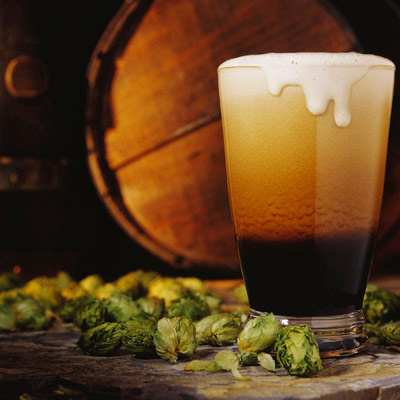Common Name: Hops
Scientific Name: Humulus lupulus
Family: Cannabaceae (Hemp Family)
Description:
Hops are twining perennial climbers that are fairly drought tolerant. The female plants produce flower cones (also called hops) that are used to provide bitterness and preservation to beer. There are a number of full sized and dwarf varieties, and as a homebrewer of beer I plan to grow quite a few varieties when I finally get the chance.
History:
The first documented cultivation of hops was in 736 AD in Hallertau region (part of Bavaria) of Germany. Hops have been growing here ever since, and close to one quarter of the world’s hops are now produced in this area. However, in the first century, hops was not a prime beer additive. Over time, in spite of legal battles and elitists’ bans on the plant, hops eventually became the primary bittering agent and preservative in beer. It was first grown in the U.S. in 1629.
Trivia:
- The female plant produces clusters of flowers called Cones or Strobiles. These resemble pale, drooping, green flowers.
- Only cones from the female plant are used in beer making.
- Before hops, a wide variety of flowers and herbs were used to bitter the sweet malted barley: marigold, dandelion, burdock, horehound, heather, etc.
- Most hops are dried before using in beer.
- The resins in the flowers are what give the distinct qualities to hops. The two main components are alpha and beta acids.
- Alpha acids are responsible for the antibiotic effect and the bittering flavor in hops.
- Beta acids are responsible for the aroma – I love this aroma!
- The “Noble Hops” (Hallertau, Tettnanger, Spalt, and Saaz cultivars, all German) are classic low bitterness, high aroma hops, although some consider two English varieties (Fuggles and East Kent Goldings) to be “Noble” as well.
Primary Uses:
- Female “flowers” (Cones) used in beer making
Secondary Uses:
- Young Spring shoots can be cooked as vegetables, like asparagus, and was a Roman specialty
- Tea (cones and/or leaves)
- Medicinal uses – historically used for anxiety, restlessness, insomnia, and anti-bacterial agent.
- has been used in sausages, cereals, non-beer beverages, tobacco, and perfumes.
- Stems have been thought to produce fiber and paper.
- Leaves and cones used to produce a brown dye
Yield: Varies greatly on the variety and growing conditions.
Harvesting: Female cones are harvested in autumn. Bloom to harvest is about 40 days.
Storage: Unless used immediately, drying is the best method for preservation. Once dried, hops can be stored in a sealed bag (as close to vacuum as you can get it) for many months. This can extend the brewing potential of home raised hops.
DESIGNING WITH THIS PLANT
USDA Hardiness Zone: 4-5
Chill Requirement: Likely, but none documented that I could find
Plant Type: Large herbaceous vining/climbing plant
Leaf Type: Deciduous
Forest Garden Use: Vertical Layer (Vining/Climbing)
Cultivars/Varieties: Many varieties available.
Pollination: Hops are dioecious (male and female plants). You only need one male vine for a number of female plants if you are interested in propagating from seed; however, this is rarely done.
Flowering: Summer
Life Span:
Years to Begin Bearing: 2-3 years
Years to Maximum Bearing: 3-4 years
Years of Useful Life: No good information found
PHYSICAL CHARACTERISTICS OF THIS PLANT
Size: 15-30 feet (4.5 – 9 meters) tall and wide; some dwarf varieties exist that are about half this size
Roots: Rhizomatous – underground stems that send up shoots and down roots
Growth Rate: Medium to Fast depending on the variety
Light: Prefers full sun
Shade: Tolerates moderate shade
Moisture: Medium moist to dry
pH: prefers fairly neutral soil (6.1 – 7.0)
Special Considerations for Growing:
Hops has been grown commercially for a long time, so there are some very specific ways in which it is grown to produce maximum yields, make harvesting easier, make treating pests easier, and make the most money… however, if you plant hops in a Forest Garden setting, then you can pretty much plant it is a sunny, well ventilated location with a structure/support to grow, and leave it be!
Martin Crawford, world expert on forest gardening, recommends growing hops on the south side of large, non-fruiting/nut trees like the nitrogen-fixing Alders. This allows nitrogen for the fast growing hops, structure for the hops to climb, but does not inhibit yield of a high production tree. Brilliant!
Propagation: Root cuttings, division (in Spring), or layering. Rarely grown from seed as it will not produce true to type… meaning, plants grown from seed will produce plants with very different flower characteristics. Since the flowers of specific varieties are used to give distinct flavors and aromas to beer, then growers usually want these characteristics preserved… hence the aforementioned propagation methods.
Maintenance:
Minimal once established. Some forest gardeners will leave the old stems as a trellis for new growth.
Concerns:
Poisonous to dogs – results in hyperthermia, seizures, and death.
Some people can develop dermatitis (skin irritation) while picking the hops.
Sprawling vigorous growth can overtake some areas if not kept in check or planted with the growth in mind.

















